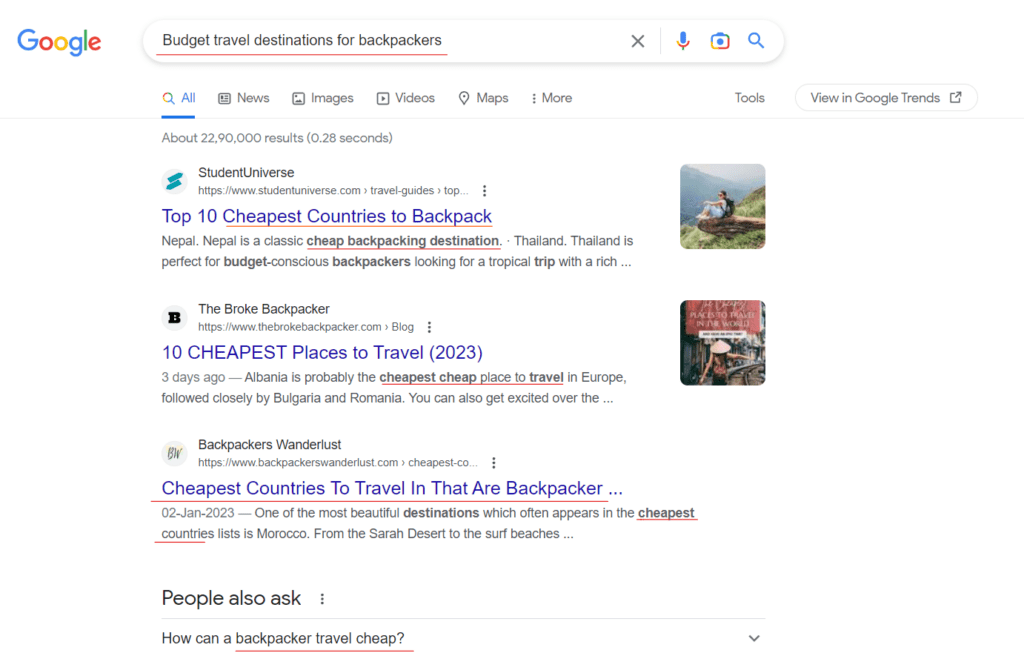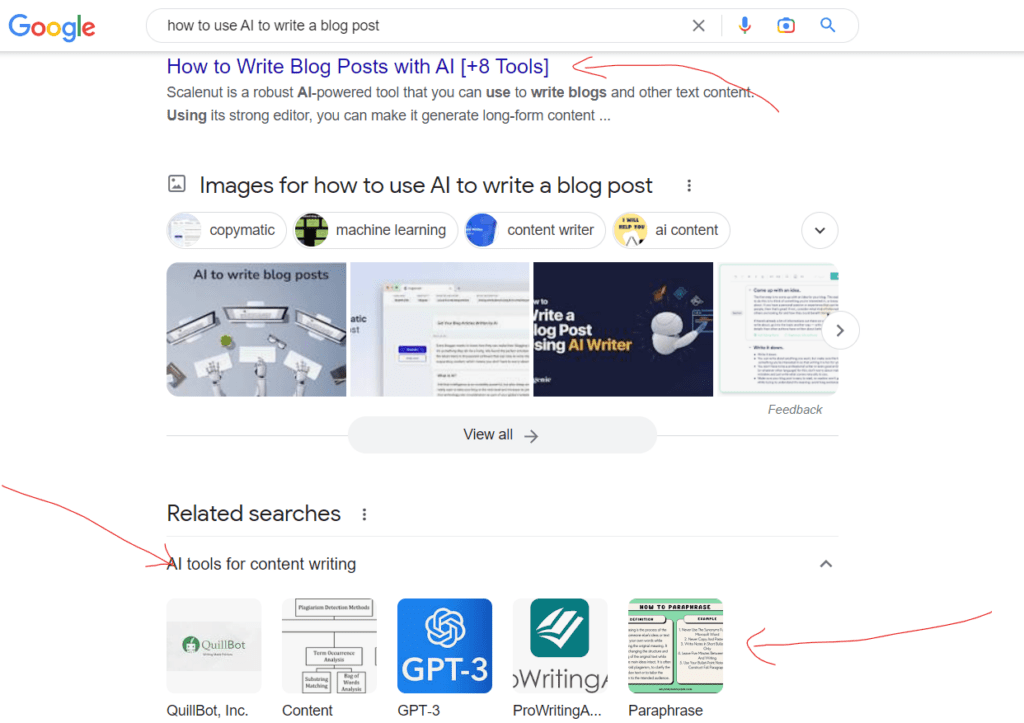You can’t ignore Search Engine Optimization (SEO) if you want to win in the digital world.
If you want more traffic and a strong online presence, then you need your content to rank high in search engine results.
And to do this, you need to leverage SEO techniques, specifically SEO content writing tips.
But you need to build written content that’s relevant and optimized.
You can write hundreds of engaging and informative articles but it won’t matter if they remain invisible to your readers.
In this post, you’ll learn all about writing for SEO.
Here’s all the information a beginner needs to master on page SEO, SEO copywriting, and everything that goes into boosting your post rankings with content.
What Is SEO Writing?
SEO writing refers to the process of optimizing content for better search engine rankings.
It means you need to write content that includes relevant keywords, ensures a smooth user experience, and adheres to search engine guidelines.
When done correctly, SEO content writing can significantly improve organic traffic and help businesses reach more readers.
But to write SEO-friendly content, you need to understand how search engines work and the basics of SEO content writing.
You also need to be mindful of keyword density, readability, and other factors that directly impact search engine rankings.
We’ll cover all these details in this post. So, keep reading to learn everything you need to know to become an SEO writer or SEO copywriter.
How Does SEO Help In Ranking Your Content?
So SEO makes your content rank higher in Google’s search results.
But how exactly does this work?
The answer is – by providing helpful content.
One of the latest updates by Google says that its algorithm will prioritize useful, helpful content “written by people, for people”.
And SEO plays a role in making this happen.
A huge part of SEO revolves around identifying and using the right keywords when creating content. But that’s just the tip of the iceberg – there are many other factors that matter. But for the scope of this post, we’ll look at SEO writing alone.
Keywords are the terms or phrases that people type into a search engine to find what they’re looking for.


So, when you identify the right keyword that will bring more people to your content, you stand to see your web page appear at the top of a search engine results page or SERP.
And the practice of SEO writing will help you incorporate keywords well and also use related terms, phrases, keywords, and topic clusters to make your post more relevant.
When you add relevant and useful content to your blog posts, search engine bots that ‘crawl’ through your writing will be more likely to rank them for your choice of keyword.
Let’s look at an example to make this clear.
Say you run a small business selling organic skincare products online.
You want to improve your online visibility and attract more customers to your website. One way to do this is by optimizing your content for search engine algorithms using SEO writing.
To start, you may decide to focus on the keyword “organic face cream”.
By incorporating this target keyword into your website content, blog posts, and product descriptions, you can help search engines understand that your website is relevant to people searching for this product.
As a result, your website may appear higher in SERPs when people search for “organic face cream”.


While we don’t know exactly how Google ranks content, it’s a safe bet that keywords, backlinks, and other factors in your content matter.
Google, Bing, Yandex, and other platforms also consider title tags, meta descriptions, alt tags, etc.
And based on their findings, they assign a score to your content. And the higher your content’s score, the higher it will rank in the SERP.
You can influence this score with the right SEO writing techniques!
Benefits of SEO Writing to Influence Search Engines
Here’s what makes SEO writing important. These are some potential results you could get from using SEO writing to support your digital marketing:
- Increased website traffic: By appearing higher in SERPs for your target keyword, more people may click on your website and visit it.
- Improved engagement: By writing content that is high-quality, informative, and relevant, you can improve engagement with your website visitors and potential customers.
- Higher conversion rates: By attracting more targeted traffic to your website, you may see an increase in conversion rates and sales.
- Enhanced brand awareness: As more people become aware of your business through search results and online content, your brand may become more recognized and trusted in the industry.
- Boost domain authority: Informative, relevant, and helpful content will lead your website to grow its DA or domain authority. This is a score that indicates how trustworthy your site is ranging from 0-100. The higher your DA, the more trustworthy your site and the more likely your posts will show up as top results.
Overall, by using SEO writing to optimize for specific keyword rich phrases, you can boost your content marketing and grow your online presence.
14 Steps to Master SEO Writing
The following SEO writing tips will help you master content optimization so that Google, Bing, and other platforms notice your content.
While this guide seems complex at first, it’ll make sense and become second nature in no time. Especially when I help you with the right tools and mindset to master SEO writing.
1. Start With Goals
When you do SEO writing, your main goal is to:
- Create relevant, useful, and optimized content
- Focus your content around a keyword that is relevant to your industry and customers too
- Build blog posts, web page content, and landing pages that appear at the very top of Google when people type a specific keyword
- Drive traffic, get more engagement, and conversions like sales or building your newsletter
Everything you do next makes sense when you’re clear about your goals. By realizing that you’re writing content to rank high, you’ll avoid being overly creative and generating content that doesn’t help readers.
2. Do Keyword Research
As an SEO writer, you may have to either find out the right key phrases yourself or your client/boss will tell you what to focus on.
If it’s the second case, you don’t have to worry about doing research on your own.
When doing keyword research, you need to use both keyword research tools and common sense to pick important keywords.
For example, if you run a taco restaurant in Charles St. then ‘best taco restaurant in Charles St.’ is a common sense keyword you should work on.
You can also use keyword research tools like Ahrefs, Semrush, and Ubersuggest to get more ideas. These tools will also help you learn about the traffic potential and competition for different key terms. We’ll cover keyword research in greater detail in another post.


Ultimately, SEO writing rests on using an appropriate keyword to build content on and you should define this early on.
3. Identify related key terms, phrases, and topic clusters
So far, I’ve stated that your blog or site content should focus on a single keyword.
However, this isn’t strictly true.
When writing on a specific topic or keyword, you also have to build context. And this is possible when you include other topics that are related to your original keyword.
Adding related terms and phrases along with your focus keyword is known as latent semantic indexing.
Here’s a simple breakdown of what it means.
Think of the story of Cinderella – a story about this character isn’t complete unless it includes a glass slipper, a fairy godmother, a wicked stepmother and stepsisters, a prince, a pumpkin, and ‘midnight’.
Likewise, a focus key phrase like ‘places to visit in New York’ must include the Empire State Building, The Statue of Liberty, Brooklyn Bridge, and so on to be relevant.
When optimizing content, don’t just focus on one key term, also think about closely related terms that are linked to it.
Check Google search results or use an SEO tool like SurferSEO to help find such related content.
4. Do your research
At this stage, you can do two things – research your topic or build an outline. If you already know what to write, then you should skip ahead to creating a blog post outline.
But if you’re still unsure of what content to create, research is necessary. It doesn’t have to be too complex – here’s a simple checklist you can use:
- What are the most popular posts on this topic? See the top ranking results on Google’s search results page.
- What questions does your target audience ask about it? Check the ‘People Also Ask’ section of a search results page.
- How can I answer these questions better than others? Identify what’s missing in the posts that already exist.
- What other related topics can I write about? Again, use Google search and SEO tools to find related blog post ideas.
I’ll dive in-depth into how you can make SEO writing accurate, easier, and faster with the right tools. For now, learn these fundamentals to understand how writing to optimize works.


5. Create an outline
At this point, you should have a good idea of what your content will be about. it’s now time to create an outline for your post so you can organize the thoughts and information that comes out of your research.
This is a crucial step, as having an outline will make writing content much faster.
Your outline should include headlines, subheads, and bullet points that cover all the points you want to discuss in your post.
You can also use an outline to check if the content you’ve created covers all the main points of your topic. I’ve created a detailed post about building an outline that will help you structure your work well.
6. Structure your content
While this is a part of the previous point on creating an outline, it’s important enough to have a section dedicated to it.
The structure of your content will determine how easy or difficult it is for your target audience to read. So, make sure you include headings and subheadings in the right places with the right keywords.
The reason why you should use heading and subheads is that it not only breaks up your posts into bite-sized chunks, but it also tells Google what the page is about. This way, your content can be categorized and indexed correctly.
Another important factor when it comes to structuring is your formatting. This includes using bold, italics, and lists to make your post visually appealing.
You should also use paragraphs and bullet points to break up the text and make it easier to read.
Here’s a brief idea on how you should structure and format your posts:
- Post Title
- Introduction
- First heading (in H2)
- Second heading if any (in H2)
- Subheadings (in H3)
- Concluding paragraph
Using the right formatting and structure plays a big role in ranking your content is a critical part of writing for SEO.
7. Start writing
With all the above steps done, you can now start writing your content.
Make sure that you include relevant keywords in the right places throughout your post.
You should also link to other relevant articles, as this will help Google understand what your content is about.
Finally, make sure that the content is well-written and engaging. SEO isn’t just about optimizing for search engines but also about providing a great user experience.
So take some time to polish your post and make sure it’s something your readers would enjoy.
When you’re done writing, proofread and edit to make sure there are no typos or grammatical errors.
There’s one more step you should do before you publish your post. Keep reading.
8. Use a readability app
Readability is an important factor when it comes to SEO and user experience. You should make sure that your post is easy to read and understand.
For this, you can use a readability tool like Hemingway App or Grammarly. These tools help improve the quality of your content by checking for typos, and grammar mistakes, and if you should simplify your writing.
These tools will also detect of you’re using the passive voice which is a no-no.
Write in the active voice and keep your sentences short and to the point.
Once you’ve finished editing, you’re ready to hit publish.
9. Avoid keyword stuffing
Targeting the right keywords is a vital aspect of SEO writing. But remember you should never cross the line into keyword stuffing.
This is where you repeat the exact keywords over and over again to create an unnatural experience. When you keep on repeating the keywords too many times, the search engines may recognize it as spam.
A search platform like Google is smart enough to tell when you’re attempting to push irrelevant content up their rankings. And the moment it identifies any spammy keyword stuffing, it’ll ignore your content.
Or worse, penalize your domain and keep it from ever appearing online.
Besides, jamming keywords makes for an unpleasant reading experience and drives readers away from your website.
So, avoid overusing key phrases and terms and focus on quality content that naturally incorporates target keywords without overdoing it.
10. Distribute keywords in the right places
There are several places in your blog where it’s important to include keywords for SEO. Here’s where to add relevant keywords:
- Your title is the first and foremost place where you should incorporate target keywords. This will make it easier for search engines to identify what the content is about.
- Your meta description should also contain relevant keywords, and make sure it’s below 155 characters.
- Make sure you add the focus key term in the first few paragraphs of your content
- Include it in headlines and subheadings
- Add it to your image alt-text field
In this way, you can distribute keywords in the right places and make sure that Google recognizes your content.
11. Add external links
Linking to authoritative sites is an SEO writing best practice. It’s a way of telling Google that you are providing quality content.
You can link to other articles on your website to provide more background information and reinforce concepts.
You can also link out to relevant websites that are respected and authoritative.
12. Add internal links
An internal link is a link from one page on your website to another. This can help search engines and visitors find related content by taking them to different pages on your website.
Using internal links also creates a better user experience and encourages visitors to explore other pages. This can help reduce bounce rates and increase the time visitors spend on your website.
13. Include FAQs and ‘People Also Ask’
These days, the search engine results pages (SERPs) include special sections for featured snippets, FAQs and “people also ask” boxes.
Including these elements in your post can help you get better exposure and increase chances of appearing in relevant search results.
You should create a list of questions that people might ask about your topic and provide answers accordingly. This will not only make your content more helpful but also improve the chances of appearing in the SERPs.
14. Bonus: Use SurferSEO to make everything easier
Everything I’ve shared so far will help you create SEO-friendly blog posts. But there’s an even easier way to do this with SurferSEO.
SurferSEO is a Content Editor tool that helps you write the perfect content for any keyword.
Instead of having to guess what keywords and related terms to include in your post, you can use SurferSEO to get all the information you need.
It will analyze the top ranking content for any given keyword and suggest improvements that you can make to optimize your content for SEO.
This makes it incredibly easy to write SEO-friendly blog posts quickly and competently.
You’ll know how many words to write, how many paragraphs you should have, how many times to repeat a phrase, and so on.
Ultimately, if you want to offer professional SEO writing services, you must use a tool like SurferSEO to optimize your content and make it stand out.
By following these tips and using the right tools, you can easily create SEO-friendly blog posts that will help boost your website’s ranking in search results pages.
Bottom Line
Writing SEO-friendly content requires you to keep a lot in mind.
From using the right keywords to optimizing URLs and including related words, you need to do a lot of things.
And speaking from experience, with practice it becomes easier for you to write content that’s optimized for search engines and readers alike.
Just keep the SEO content writing tips mentioned in this article in mind, and you’ll be fine. You’ll be able to create content that will rank higher and engage readers easily.
So, begin today and get your website and posts to the top of the the SERPs.
FAQs
How to start SEO content writing?
Ans: Now writing a post and writing an SEO-optimized post are two different things. That’s why to start with SEO writing, you need to first select a keyword that best describes your topic and use it throughout the post.
But be careful not to do keyword stuffing. Also in SEO writing, be sure to use other related keywords or synonyms wherever necessary.
Hence, to start SEO writing you’ll need to understand the keyword game and learn the art of including them in the post.
Plus you’ll also have to learn to link out to relevant sources as the linking strategy is also a big part of SEO.
How to learn SEO writing for free?
Just type ‘SEO content writing’ in Google and you’ll get a lot of free resources to help you learn SEO. You don’t need to enroll in a course to learn SEO writing.
Watch tutorials on YouTube, and read blogs, articles, and ebooks related to SEO content writing.
However, the best way to learn SEO and content marketing is to get experience. In your free time, begin practicing writing posts with keywords and linking them to relevant sources. Show these posts to your mentors or connections who know about SEO writing.
Ask them for feedback and use them while practicing next time. With practice, you’ll be a pro at SEO content writing eventually. As for the Keyword finding part, there is a number of free automated keyword-generating tools present online. I suggest UberSuggest to begin with.
Just make use of those to easily find the right keywords for your content.
What Skills Should SEO Writers Have?
An SEO content writer makes content that is optimized for search engines. They are aware of best practices in boosting content quality, and they help achieve the goals of a business’s content strategy.
As an SEO copywriter, writing content is just one part of the job. You have to be creative and strategic.
You need to know how to keep your blog post flowing while inserting different keywords in the right places.
For instance, if you’re writing an article on weight loss, then you’ll use phrases like ‘diet for weight loss’, ‘healthy diet plan’, or ‘ weight loss tips; in your copy.
You’ll also add relevant terms like ‘drink water’ or ‘eat more protein’ because these terms are often related.
We’ll dive deeper so you can learn everything you need to know to create SEO-optimized copy.
Discover valuable tips to engage your readers while simultaneously meeting the requirements of your content strategy or SEO strategy.



